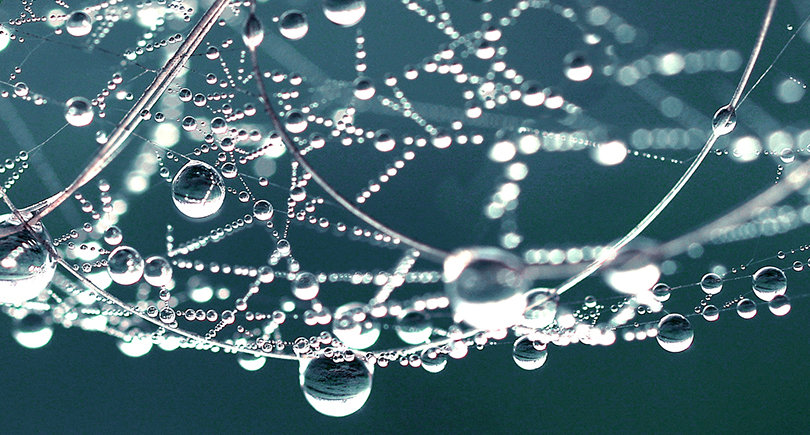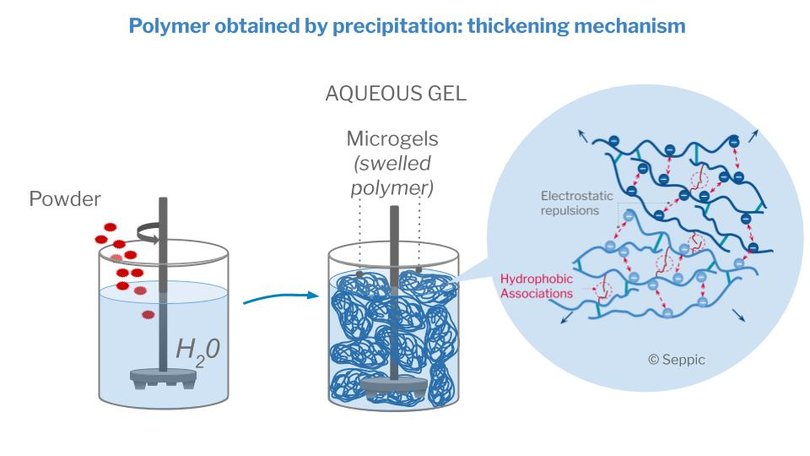Polymerization
A technology to support formulators
Thickening polymers are among the most-used ingredients in formulations. Because of their ability to govern rheological behavior, they are essential ingredients for controlling usage performance and ensuring users have a positive perception of the products.
At Seppic, we use two main polymerization technologies: inverse emulsion polymerization and precipitation polymerization.
Inverse emulsion polymerization
Inverse emulsion polymerization is an effective manufacturing technology for producing high-performance liquid thickeners. Pre-neutralized and ready to use, these polymers can be used cold during the formulation of end products.
Inverse emulsion polymerization technology
Inverse emulsion polymerization technology is a process of radical polymerization which consists of polymerizing ethylenic and hydrophilic monomers, which are soluble in water droplets, dispersed in an oily phase and stabilized by a low HLB (hydro lipid balance) emulsifier system.
This technology leads to the formation of high molecular weight polymers trapped in water droplets dispersed in a water-in-oil emulsion. Depending on the targeted properties, the structure of the polymer can be adapted through the choice of the monomers and the crosslinking system.

A unique multifunctional character
The intrinsic morphology of the polymer resulting from this process is an important part of its final properties and gives it a unique, multifunctional character. When introduced into water, the polymer gives rise to perfectly spherical microgels of small sizes, forming a dense network which allows the combination of:
- thickening performance,
- effective stabilization of oily phases when cold,
- non-stringy texture,
- non-sticky touch.
This technology is used, for example, to obtain thickening agents for the formulation of cream-gels with stabilization of an oily phase without the addition of a surfactant. The cream-gels have the advantage of having a light texture, more suited to hot and humid climates or to oily skin.
|
Scientific communication |
Environmental benefits
Inverse emulsion polymerization has environmental benefits:
- No need for a solvent, the oily phase is part of the final product and contributes to the properties of the thickener,
- No waste generated,
- Low temperature process (below 100°C): the heat given off by the polymerization reaction makes it possible to limit the energy consumption necessary for production,
- Biobased raw materials for polymers: the oily phases and the surfactants used in the process contribute to the renewable carbon rate. For example this is the case of Sepilife™ Nude, containing a 100% biobased alkane.
Easy-to-use liquid or powder polymers
The inverse emulsion polymers developed by Seppic, such as Sepiplus™ 400, Sepilife™ Nude and Sepineo™ P600, are easy to use by final product manufacturers:
- No need for neutralization: the polymers are pre-neutralized during the synthesis process.
- No need to add surfactants: the inverse latex composition is adjusted to obtain a spontaneous phase inversion when added in water, which makes it possible to obtain an oil-in-water type emulsion.
- No need for high shear during formulation: after phase inversion, the polymer chains are deployed in the aqueous phase, thanks to electrostatic repulsions between the anionic groups.
With an additional drying step polymers in powder form are obtained, such as Sepinov™ EMT10 and Sepineo™ Derm for topical applications in cosmetics and dermopharmacy. This two-step process allows the powder polymer to retain all the advantages of inverse emulsion polymers, the ease of dispersion in water as well as its multifunctional character.
Precipitation polymerization
Precipitation polymerization achieves new levels of performance. This technology requires a high degree of mastery of both the industrial process and industrial transposition. This type of polymer is produced, for example, by Seppic in its Polykon Manufacturing factory in Richmond, (Virginia, United States).
Precipitation polymerization technology
Radical precipitation polymerization is a process to synthesize cross-linked high molecular weight polyelectrolytes, with a high level of performance, particularly with regard to the thickening and texturizing properties once dispersed in water. This is the process for obtaining Sepimax Zen™ and Sepineo™ PHD 100 polymers for topical products in cosmetics and dermopharmacy or Solagum™ EL X for industrial applications, such as detergents or construction. Polyelectrolytes are obtained from monomers from fossil resources.

Amphiphilic and ready-to-use polymers
Precipitation polymerization is used to obtain amphiphilic polymers with improved electrolyte stability of the formed gels, which is called the "chassis effect". The viscosity of the gel produced from these polymers remains stable when adding salts. For formulators, the texture remains stable despite the addition of electrolytes in the formula, without needing to constantly adjust the viscosity.
The polymer gels are stable over a wide pH range, making them very versatile and usable in different types of formulations. It is possible to form gels with a flow threshold and therefore interesting suspensive properties (suspension of pigments, fillers, flakes, air bubbles, etc.).
|
Scientific communication |
As with the polymers by inverse emulsion, the polymers resulting from the precipitation polymerization are ready-to-use polymers that do not require a neutralization step by the formulator. They contribute to the reduction of the energy expenditure by being formulated at cold, under low shear.
Pure polymers
The polymers obtained by precipitation polymerization can be almost pure (>90% of active material and free of oil), which allows the formulation of transparent gels. This gives the product user a perception of purity, which plays a role in their sensations and sensory experience.
Research to improve naturality and benefit the environment
Polymerization technologies continue to evolve, as do the expectations of product users. At Seppic, our goal is to develop rheology modifiers with ever stronger environmental and natural components, while maintaining exceptional performance. Seppic is progressing in its research program on polymers around bio-based raw materials, biodegradability, biotechnologies and ever more environmentally friendly processes.






